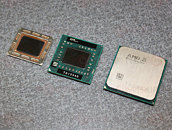Thursday, January 12th 2012

AMD Trinity APU Pictured in its Three Package Options
At CES, AMD is grabbing some eyeballs with a fascinating real-world capability demo of the AMD "Trinity" accelerated processing unit. At the same booth, AMD displayed the Trinity silicon in three different packages, for three different form-factors. The first one (to the left), also pictured in the earlier article, is a compact FP2 BGA (ball-grid array) package, designed for ultra-compact notebooks, ultrabooks, etc.
The second one (center) is the FS1r2 uPGA package for mainstream notebooks with slightly relaxed space and board footprint constraints. Unlike the FP2 BGA package, the FS1r2 uPGA is socketed, with extremely tiny pins. The FS1r2 uPGA is significantly bigger than FP2 BGA. The third, more familiar-looking package is the FM2, for desktops. FM2 is an updated version of FM1, on which current Llano A-series desktop APUs are based. Unfortunately, FM1 and FM2 are not compatible in any way. Learn more about the FM2 package in our older article detailing it, here.
The second one (center) is the FS1r2 uPGA package for mainstream notebooks with slightly relaxed space and board footprint constraints. Unlike the FP2 BGA package, the FS1r2 uPGA is socketed, with extremely tiny pins. The FS1r2 uPGA is significantly bigger than FP2 BGA. The third, more familiar-looking package is the FM2, for desktops. FM2 is an updated version of FM1, on which current Llano A-series desktop APUs are based. Unfortunately, FM1 and FM2 are not compatible in any way. Learn more about the FM2 package in our older article detailing it, here.

41 Comments on AMD Trinity APU Pictured in its Three Package Options
In CPU low end and mainstream...AMD CPUs provide the same performance for a much lower price
In the Server market Interlagos 12C is right on Westmere 6C with a much lower price and Interlagos 16C is between Westmere 8C and 10C with much lower prices(I mean much lower prices 6282 SE is $1000-1100 and Westmere 10C variants are within $3000-$5000 huge difference)
With no Sandy Bridge-E competition against the Interlagos CPU anytime soon(Interlagos already has 2P and 4P motherboards available while Sandy Bridge-E only has 1P..since the price to get one i7 3960+1P Motherboard is the same price as two 12C Interlagos+2P Motherboard, If CPU over GPU is the problem I would go for Interlagos over Sandy Bridge-E)
High-end depends on the application...
So for Trinity to have the same clocks as Llano....
Trinity "A8-3870K" comparible
3.0GHz CPU
600MHz GPU
~50W TDP
That is why they were able to get 17W Trinity parts(They are the same frequencies as the 35W Llano part)
There is a few rumours going around trying to explain why TDP is halved with Trinity and Vishera*....but most of them revolve around 32nm-SHP not being complete
*1/3rd
It was more of this^ 16x Integer SSE4.1
Bulldozer Version 1 is heavily aimed at Integer XOP/SSE4.1/4.2/AVX/FMA4 workloads
Bulldozer Version 2E(Trinity) is heavily aimed at above +FMA3
Bulldozer Version 2L(Vishera) is aimed at improving SSE2-SSE3 performance
With Bulldozer Version 3 aimed at improving Floating Point Performance
Transcoding is done via Integer workloads not Floating Point workloads
X.264 Integer
H.264 Integer
FLAC Integer
and so on
so when you see AMD Performance on Digital Media Workloads that means Integer performance has gone up!
I say no chance of any competition on the high end, but they said it was for "mainstream" systems anyway, so everybody needs to be realistic. This is not meant to hold anything against Intels top chips.
Typical AMD, hey, we can do this new thing 2X faster than the other guys. Nevermind that no one is using it yet, and by the time they do we will be three generations beyond this processor, we can do it NOW....
ATI did the same thing with CTM, Stream, and other apps.
Thanks.